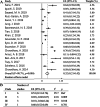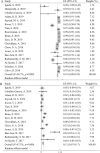Is the superbug fungus really so scary? A systematic review and meta-analysis of global epidemiology and mortality of Candida auris
- PMID: 33176724
- PMCID: PMC7656719
- DOI: 10.1186/s12879-020-05543-0
Is the superbug fungus really so scary? A systematic review and meta-analysis of global epidemiology and mortality of Candida auris
Abstract
Background: Candida auris is a new pathogen called "superbug fungus" which caused panic worldwide. There are no large-scale epidemiology studies by now, therefore a systematic review and meta-analysis was undertaken to determine the epidemic situation, drug resistance patterns and mortality of C. auris.
Methods: We systematically searched studies on the clinical report of Candida auris in Pubmed, Embase and Cochrane databases until October 6, 2019. A standardized form was used for data collection, and then statics was performed with STATA11.0.
Results: It showed that more than 4733 cases of C. auris were reported in over 33 countries, with more cases in South Africa, United States of America, India, Spain, United Kingdom, South Korea, Colombia and Pakistan. C. auirs exhibited a decrease in case count after 2016. Clade I and III were the most prevalent clades with more cases reported and wider geographical distribution. Blood stream infection was observed in 32% of the cases, which varied depending on the clades. Resistance to fluconazole, amphotericin B, caspofungin, micafungin and anidulafungin in C. auris were 91, 12, 12.1, 0.8 and 1.1%. The overall mortality of C. auris infection was 39%. Furthermore, subgroup analyses showed that mortality was higher in bloodstream infections (45%), and lower in Europe (20%).
Conclusions: Over 4000 cases of C. auris were reported in at least 33 countries, which showed high resistance to fluconazole, moderate resistance to amphotericin B and caspofungin, high sensitivity to micafungin and anidulafungin. The crude mortality for BSI of C. auris was 45% which was similar to some drug-resistant bacteria previously reported. In conclusion, C. auris displayed similar characteristics to some drug resistance organisms. This study depicts several issues of C. auris that are most concerned, and is of great significance for the clinical management.
Keywords: Bloodstream infection; Candida auris; Case count; Clade; Drug resistance; Mortality.
Conflict of interest statement
The authors declare that they have no conflicts of interest.
Figures




References
-
- Rhodes J, Fisher MC. Global epidemiology of emerging Candida auris. Curr Opin Microbiol. 2019;52:84–9. - PubMed
-
- Lockhart SR, Etienne KA, Vallabhaneni S, Farooqi J, Chowdhary A, Govender NP, et al. Simultaneous emergence of multidrug-resistant Candida auris on 3 continents confirmed by whole-genome sequencing and epidemiological analyses. Clin Infect Dis. 2017;64(2):134–140. doi: 10.1093/cid/ciw691. - DOI - PMC - PubMed
-
- Chow NA, Gade L, Tsay SV, Forsberg K, Greenko JA, Southwick KL, et al. Multiple introductions and subsequent transmission of multidrug-resistant Candida auris in the USA: a molecular epidemiological survey. Lancet Infect Dis. 2018;18(12):1377–1384. doi: 10.1016/S1473-3099(18)30597-8. - DOI - PMC - PubMed
Publication types
MeSH terms
Substances
Grants and funding
LinkOut - more resources
Full Text Sources
Medical

